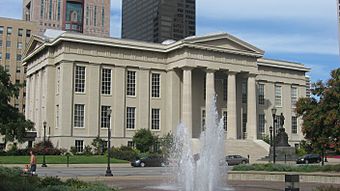Louisville Metro Hall facts for kids
Quick facts for kids |
|
|
Jefferson County Courthouse
|
|

Front of the courthouse
|
|
| Location | 527 W. Jefferson St., Louisville, Kentucky |
|---|---|
| Built | 1835 |
| Architect | Gideon Shryock |
| Architectural style | Greek revival |
| NRHP reference No. | 72000537 |
| Added to NRHP | April 10, 1972 |
The Louisville Metro Hall is a very important building in Louisville, Kentucky. It's where the city's government works. Today, it holds the Mayor's Office and the Jefferson County Clerk's Office. This is where people get marriage licenses and handle important paperwork.
The building was added to the National Register of Historic Places in 1972. This means it's a special place with a lot of history. Building the hall started in 1837. Both the city of Louisville and Jefferson County governments began using it in 1842.
Building's Look and Style
The main architect for the Louisville Metro Hall was Gideon Shryock. He had big plans for the building's look. He wanted it to have a large front porch with six columns in a classic Greek style, called a Doric portico. He also planned for a small dome on the roof, known as a cupola.
Shryock also wanted more porches on the sides of the building. He imagined decorative panels and a flat band of stone above the columns. However, Shryock left the project in 1842. The building was finally finished in 1860. Albert Fink, who designed bridges, and Charles Stancliff took over.
Fink changed some of the original plans. He used fewer columns for the front porch. He also decided not to build the extra side porches or the dome. At the time, a local newspaper called the Louisville Daily Journal even said it looked like a "elephantine monstrosity."
History of the Hall
Construction on the Louisville Metro Hall began in 1837. By 1842, both the City of Louisville and Jefferson County governments were using the building. In the 1840s, the area around the courthouse was a place where important discussions about freedom and slavery happened. Both sad events like slave trading and powerful speeches calling for the end of slavery took place near the courthouse.
When the building was first planned, some people hoped it would become the Statehouse for Kentucky. This was the goal of James Guthrie. But the state capital stayed in Frankfort. Because of this, the building was sometimes called "Guthrie's folly."
The building did get some state government use during the American Civil War. It briefly housed the Kentucky State Legislature. This happened when Confederate forces took over Frankfort.
After a fire in 1905, the building was fixed up by Brinton Davis. In 1948, a famous architect named Frank Lloyd Wright visited Louisville. He talked about the Courthouse, saying that Louisville's old buildings were special. He believed we should keep these historic buildings, even if we build new ones differently. This was important because in the 1940s, some people wanted to tear down the building to make way for new city projects.
The building was officially listed on the National Register of Historic Places in 1972. Many improvements have been made over the years. A statue of Henry Clay, created by Joel T. Hart, was placed inside. The building also had major renovations in the 1980s. Another nearby building, the Jefferson County Courthouse Annex, was also added to the National Register in 1980.
The Louisville Metro Hall used to be called the Jefferson County Courthouse or Louisville Courthouse. After the city of Louisville and Jefferson County joined together, the building got its new name. Now, it mainly holds the offices of the Mayor of Louisville Metro. You can also find the Jefferson County Clerk's office and some Kentucky court offices here.
Statues Outside the Hall
There are two important statues located outside the Louisville Metro Hall. In front of the building, you can see a statue of Thomas Jefferson. This statue was made by Moses Jacob Ezekiel and given to the city in 1901.
The second statue is on the corner of Sixth and Jefferson streets. It's across from the Louisville City Hall. This statue is of King Louis XVI. It was a special gift to Louisville from its sister city, Montpellier, France. The statue was given on July 17, 1967. Many important people from France and America were there for the presentation. Montpellier's Mayor officially gave the statue to Louisville Mayor Kenneth Schmied.
The statue of King Louis XVI was sculpted in 1829 by Achille-Joseph Valois. It was made for the king's daughter. It was first shown in Montpellier. However, a year later, during a revolution in France, it was moved for safety. It was kept in different places, including a military base and a university. Finally, it ended up in a storage basement.
In 1899, people found that the statue was damaged, but it stayed in storage. In 1966, it was decided to give the statue to Louisville. It took seven months for the statue to travel from Montpellier to Louisville. The statue is made of white marble and weighs nine tons. It stands about 12 feet (3.7 meters) tall.
Sadly, parts of the King Louis XVI statue were damaged during protests in May 2020.
Gallery





